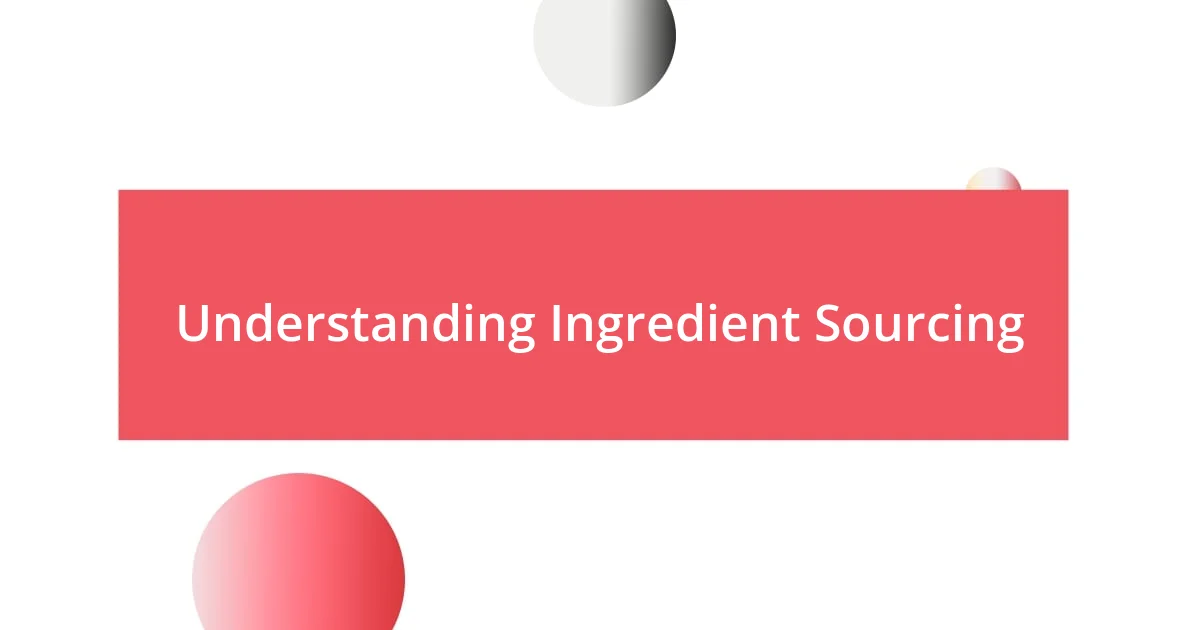Key takeaways:
- Understanding ingredient sourcing involves appreciating the stories behind food, which enhances culinary experiences and supports sustainable practices.
- Building strong relationships with reliable suppliers fosters trust, facilitates effective communication, and ensures a consistent quality of ingredients.
- Implementing a flexible sourcing strategy, including evaluating supply chains and seeking feedback, leads to improved efficiency and the discovery of unique ingredients.

Understanding Ingredient Sourcing
Ingredient sourcing is all about finding the right products that fit your standards and values. I remember the first time I visited a local farm to source ingredients for my own projects. The smells, the vibrant colors of fresh produce, and the passion of the farmers ignited a deep appreciation in me for where my food comes from. How can we expect to create exceptional dishes if we don’t know the stories behind our ingredients?
Understanding sourcing also means navigating the complexities of supply chains. It can be overwhelming at times, isn’t it? I often find myself reflecting on the various ethical implications. For example, when I choose organic over conventional, it’s not just about taste; it’s about supporting sustainable farming practices that protect our environment and communities. What’s your stance on these choices?
I’m always struck by how ingredient sourcing impacts not just flavor, but also culture and tradition. Recently, I worked with a chef who was passionate about sourcing locally grown spices. Each ingredient had a tale, a history that transformed our simple dish into a narrative on a plate. How can we overlook the rich heritage embedded in our ingredients? It’s these connections that make our culinary experiences more profound and meaningful.

Identifying Reliable Suppliers
Identifying reliable suppliers is crucial in ingredient sourcing. I often find that taking the time to build relationships with potential suppliers can lead to surprising insights. For instance, I once met a supplier at a local food expo who shared their unique harvesting techniques. It was a game changer for me, as it deepened my understanding of how the quality of ingredients directly relates to sourcing practices.
When looking for reliable partners, I recommend checking reviews and ratings. I’ve occasionally overlooked this aspect in my eagerness to find a new supplier, only to regret it later. I learned my lesson the hard way after sourcing from someone whose practices didn’t align with my standards. Developing a checklist and visiting suppliers’ facilities can help ensure that they meet your criteria for quality and ethics.
Creating a network of trusted suppliers brings peace of mind. I recall a time when an unexpected shortage threatened a dinner event. Thankfully, I had established connections, and one call to a trusted supplier ensured I had backup ingredients ready for my guests. Building these relationships over time pays off, making each sourcing decision feel more secure and reliable.
| Supplier Criteria | My Personal Insights |
|---|---|
| Quality Assurance | Visiting suppliers allows you to see their processes firsthand. |
| Ethical Practices | Understanding their values helps in choosing suppliers that align with your goals. |
| Reliability | Trust built over time can save you in emergencies. |

Evaluating Ingredient Quality
Evaluating ingredient quality is a multifaceted journey that requires not just observation but a deeper understanding. I remember a time when I was sourcing herbs for a special dish. I was drawn to the vibrant color and aroma of the basil at a farmers’ market, but I learned that true quality goes beyond just looks. The method of cultivation, the soil’s health, and even the time of harvest can make a significant difference in taste and freshness.
When assessing ingredient quality, here are some key factors I’ve found invaluable:
- Visual Inspection: Look for vibrant colors and avoid any signs of wilting or discoloration.
- Aroma: A rich, fragrant scent often indicates freshness and potency.
- Taste Testing: Whenever possible, sample ingredients to gauge their flavor profile.
- Source Transparency: Understanding where and how an ingredient is grown can reveal a lot about its quality.
- Certification and Standards: Organic or non-GMO certifications can be indicators of quality and ethical sourcing practices.
Delving into the sensory attributes of ingredients has transformed my approach to sourcing. For instance, I once attended a tasting event where I sampled tomatoes grown using heirloom seeds. The flavor explosion was unlike anything I’d ever experienced. It reinforced my belief that quality ingredients elevate not just a dish but the entire dining experience. Making the effort to evaluate quality on multiple levels can truly shift your culinary creations to the next level.

Assessing Environmental Impact
Assessing environmental impact during ingredient sourcing is something I consider essential, especially given our current climate challenges. Recently, I stumbled upon an avocado supplier who not only grew their crops organically but also implemented water conservation techniques that fascinated me. The thought of supporting a business that values sustainability just feels right, doesn’t it?
One of my go-to methods for assessing environmental impact is to look for certifications that indicate eco-friendly practices. For instance, when I learned about the difference between organic and sustainably farmed labels, it opened my eyes to how farming methods can affect ecosystems. A supplier I once worked with showcased their commitment to biodiversity, and I felt a personal connection knowing that my choices were helping to protect the environment.
I also think about the carbon footprint of transporting ingredients. The journey from farm to table can leave a lasting impact, and I’ve begun to prioritize local sourcing whenever possible. I recall a farmer’s market visit where I picked up freshly harvested vegetables—you could almost taste the reduced travel time in their freshness. It’s these small decisions that build up to make a significant difference over time. Don’t you agree that a little mindfulness in sourcing can lead to a more sustainable culinary practice?

Building Strong Supplier Relationships
Building strong supplier relationships is essential in ingredient sourcing, and I’ve seen firsthand how these connections can make all the difference. I recall a time when I collaborated with a small local farmer who not only provided me with fresh produce but also shared their cultivation stories. This relationship deepened my appreciation for what I was sourcing, making it more than just a transaction—it turned into a partnership built on trust and shared values.
Communication plays a crucial role in nurturing these relationships. Whenever I visit suppliers, I make it a point to ask questions about their processes and challenges. This open dialogue fosters a sense of loyalty and collaboration. I remember how my inquiry about a supplier’s pest control methods led to an enlightening discussion about natural remedies, ultimately enriching my approach to sourcing. Isn’t it fascinating how a simple conversation can lead to insights that transform our sourcing strategies?
Moreover, I prioritize regular check-ins with my suppliers. This might seem like an extra task, but I personally believe it’s a worthwhile investment. I once encountered a supplier facing a shortage of a specific ingredient due to unexpected weather conditions. By staying connected, I was able to pivot and source alternatives effectively, ensuring my culinary creations remained unhindered. These relationships are not just about securing ingredients; they are about resilience and mutual growth in an ever-changing landscape. Don’t you think that investing time and energy into these connections pays off in the long run?

Negotiating Pricing and Terms
Negotiating pricing and terms has always been a delicate dance for me, but it’s also where I find a lot of growth. I remember a particularly eye-opening experience when I had to negotiate with a spice distributor; they initially quoted a price that was quite high. Instead of immediately backing away, I took the time to discuss my budget constraints openly. We ended up finding a middle ground that not only met my needs but also fortified our relationship. Have you ever tried sharing your challenges in negotiations? It can really transform the outcomes.
One technique I often rely on is understanding the full context of pricing. During another negotiation for bulk grains, I inquired about their pricing structure and uncovering market trends helped me articulate my case more effectively. It’s fascinating how suppliers often appreciate informed customers who are willing to engage in deeper discussions. This not only leverages my position but also reinforces the mutual respect we build in our partnerships.
On a broader level, I’ve learned that being upfront about my expectations for delivery schedules, quality assurance, and price adjustments can save everyone a lot of headaches down the line. I vividly recall a negotiation discussion where I laid out my terms clearly, and instead of pushing back, my supplier appreciated the clarity and reciprocated with their own terms. This transparency made the process smoother and left both parties feeling heard. When was the last time you were open about your terms in a negotiation? It can lead to some unexpected breakthroughs!

Implementing a Sourcing Strategy
Implementing a sourcing strategy requires careful planning and a willingness to adapt. I remember when I decided to redefine my sourcing approach; I started by mapping out the entire supply chain. This wasn’t just a paperwork exercise—it opened my eyes to where inefficiencies lay and how I could improve relationships with specific suppliers. Have you ever taken the time to trace your own sourcing paths? It can yield valuable insights.
Another crucial aspect I’ve experienced is staying flexible. For instance, when a pandemic disrupted my usual ingredient sources, I revisited my strategy. It pushed me to explore local farmers and new suppliers I hadn’t considered before. The result? A surprise discovery of unique ingredients that elevated my dishes, and it felt so rewarding to support nearby businesses during tough times. Isn’t it amazing how obstacles can lead to unexpected opportunities?
Finally, I cannot stress enough the importance of feedback loops. After each sourcing cycle, I evaluate what worked and what didn’t. This involves consulting with my team for input— I’ve learned that a collaborative approach often generates diverse ideas to enhance our sourcing strategy. Reflecting on past challenges has led me to make small adjustments, but those shifts have made a significant difference in our overall efficiency. What changes have you made based on feedback in your own sourcing process?















